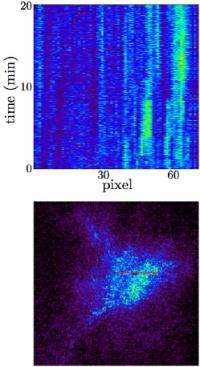How atoms behave: Characteristics of microstructural avalanches

(PhysOrg.com) -- Investigating how atoms move and rearrange themselves is fundamental to our understanding of the behavior of materials, in particular efforts aimed at engineering materials with enhanced functionality. Atomic motions occur even when materials are in equilibrium because local arrangements of atoms fluctuate about their average positions. These motions are yet more important in non-equilibrium situations, such as a transformation in which a material changes from one phase to another, for instance liquid water to crystalline ice.
Often the atomic rearrangements taking place are relatively homogeneous, occurring uniformly throughout the sample at a rate that is constant or varies slowly with time. In recent years, it has been increasingly appreciated that the dynamics in many materials is fundamentally heterogeneous; atomic rearrangement can be jerky and relatively localized.
Conventional x-ray scattering, which uses x-ray beams with a coherence length much smaller than the beam size, has long been a powerful method for investigating the structure of materials. Such scattering represents an incoherent sum of the x-rays scattered from different parts of the sample, so that only the average structure of the sample is measured. For non-equilibrium situations in which the average structure is evolving in time, conventional time-resolved x-ray scattering measures this changing average. In many cases, either the equilibrium average structure or the evolving non-equilibrium average structure is indeed the primary object of interest. However, when the primary interest is in fluctuations, the inherent averaging in conventional x-ray scattering severely limits its usefulness. This is particularly unfortunate since it is the fluctuations about the average that are most often revealing of the underlying dynamics in the material.
To avoid this averaging process and recover the otherwise lost information, x-ray photon correlation spectroscopy (XPCS) uses a partially coherent x-ray beam. Coherence is obtained by sufficiently collimating the x-rays from a high-brightness undulator at a third-generation synchrotron source, such as the U.S. Department of Energy Office of Science’s Advanced Photon Source (APS) at Argonne, to form an x-ray beam size of about 10 µm. The productive X-ray Science Division beamline 8-ID at the APS has been specially designed for these types of studies. XPCS remains, however, a relatively demanding technique and most studies have examined fluctuations in equilibrium states that exhibit relatively homogeneous dynamics.
Recently, collaborators from Boston University and McGill University published in Physical Review Letters the results of their XPCS investigation of the martensitic phase transformation in cobalt. Martensitic transformations involve a shearing of the unit cell to change the crystal structure of a material. The best known example is the formation of martensite steel, hardening the material for structural applications. In martensitic transitions, the change in crystal structure can cause a large amount of stress to build in the material. This stress can impede the further progress of the transformation, and therefore come to dictate the entire process. In cobalt the transformation is between a high-temperature, face-centered cubic structure and a low-temperature, hexagonal close-packed structure. The Boston/McGill team found that during the later stages of the change from the high-temperature to the low-temperature phase, the transformation didn’t occur gradually but was instead very heterogeneous, proceeding in sudden jumps known as microstructural “avalanches.” These sudden rearrangements of the atom stacking sequences are believed to help relieve the inhomogeneous build-up of stress that has accumulated during the transformation. While such avalanches have been previously observed by thermal and acoustic measurements in other martensitic materials, these new XPCS measurements have opened the door to structural information that reveals their spatial characteristics.
The avalanches observed in the XPCS experiments carried out at the APS span a wide range of spatial sizes: from 100 nm to 10 µm – the size of the incident x-ray beam. The avalanche rate decreases as the inverse time since the transformation began. The histogram of avalanche amplitudes A decreases as a power law A-n, with n ≈ 1.7. Intriguingly, this is quantitatively similar to the empirical laws found for earthquake magnitudes – the Gutenberg-Richter law – and for the 1/t rate of aftershocks following a major earthquake – the Omori law. The similarity may be a coincidence, but it’s interesting to note that such aftershocks release the stress in the Earth’s crust that has built due to the shift in fault plane during the main earthquake. Similarly the avalanches observed in cobalt are releasing the stress that has accumulated due to the martensitic transformation. Although the difference in scales between the two phenomena is vast, they appear to have remarkably similar dynamics.
With the emergence of XPCS as a powerful probe for measuring this type of intermittent dynamics, it is hoped that new insights will be gathered into what appears to be ubiquitous stress-relief behavior.
More information: Christopher Sanborn, Karl F. Ludwig, Michael C. Rogers, and Mark Sutton, “Direct Measurement of Microstructural Avalanches during the Martensitic Transition of Cobalt Using Coherent X-Ray Scattering,” Phys. Rev. Lett. 107, 015702 (2011). prl.aps.org/abstract/PRL/v107/i1/e015702
Provided by Argonne National Laboratory



















